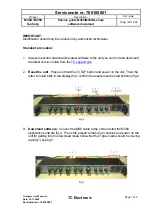
Assembling and Installing Systems
A-25
S7-400 and M7-400 Programmable Controllers Hardware and Installation
A5E00069481-04
A.9.3
Rules for the Transitions between Lightning Protection
Zones 1 <-> 2 and Greater
Rules for Transitions 1
<->
2 and Above (Local Equipotential Bonding)
for all lightning protection zone transitions 1
<->
2 and greater:
•
Set up local equipotential bonding at each subsequent lightning protection zone
transition.
•
Include all cables (also metal pipelines, for example) in the local equipotential
bonding at all subsequent lightning protection zone transitions.
•
Include all metal installations located within the lightning protection zone in the
local equipotential bonding (for example, metal part within lightning protection
zone 2 at transition 1 <-> 2
).
Additional Measures
We recommend you ensure low-voltage protection for the following elements
•
for all lightning protection zone transitions 1
<->
2 and greater
and
•
for all cables that run within a lightning protection zone and are longer than
100 m.
Lightning Protection Element for the 24 VDC Supply
You should only use the lightning conductor KT, type 24 VAD SIMATIC for the
24 VDC power supply of the S7-400. All other surge protection components do not
meet the required tolerance range of 20.4 V to 28.8 V of the S7-400’s power
supply.
Lightning Protection Element for Signal Modules
You can use standard overvoltage protection components for the digital I/O
modules. However, please note that these only permit a maximum of
1.15
V
Nom
= 27.6 V for 24 VDC nominal voltage. If the tolerance of your 24 VDC
power supply is higher, use the surge protection components for 30 VDC nominal
voltage.
You can also use the VT lightning conductor, Type AD 24 V SIMATIC. However,
this can result in the following restrictions:
•
Digital inputs: An increased input current can flow in the case of negative input
voltages.
•
Digital outputs: Dropout time of contactors can increase significantly.















































